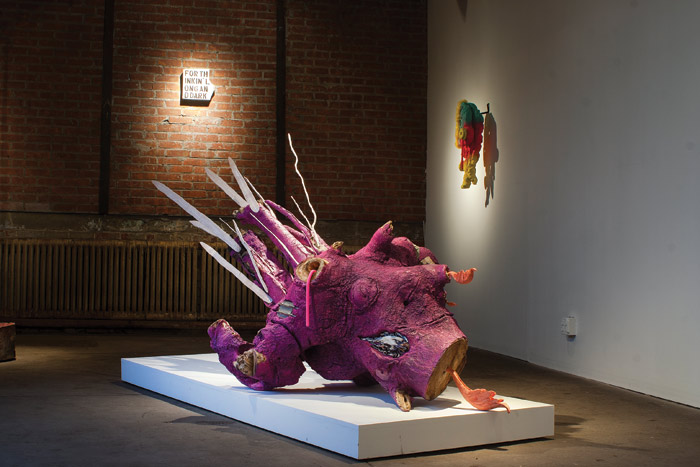“For Thinkin’ Long and Dark,” Brent Owens’ third solo show at English Kills, probably has enough distinct bodies of work in it to comprise several more tangential exhibitions. This is what’s great about it: the plurality of ideas eddy together, challenging the standards of an artist’s body of work, and the ways in which it coheres.
Owens works primarily with wood, and has a range of tools and techniques at his disposal. Not a builder with milled materials, Owens prefers to carve, whittle, chainsaw, stain, and paint his objects. They come with plenty of flare in the form of roughly textured surfaces, bright color pallets, internal lighting, chrome bits, and dollar store treasures. Some of the most striking pieces of the show are the “neon” signs, which are actually comprised of carved twigs that are brightly painted, and augmented with electrical cords in a way that mimics the typical signage of bars and storefronts. The pieces also call to mind the popularity of neon in contemporary art, exemplified by artists such as Bruce Nauman and Tracey Emin. The pieces range in scale from small hand-held objects to larger than human-size works. One of the common threads throughout the sculptures is the sensibility of their making.
The evidence of craft in Owens’ exhibition makes the work seem undeniably difficult and time-consuming. The evidence of this is not lost in final presentation, as it strongly buttresses the ideas he is presenting without completely overtaking them. This isn’t an easy feat, given the dichotomy often prescribed between idea and form in contemporary art. I am a supporter of the content-over-form legacy of conceptualism, and the fundamental belief that ideas are some of the most beautiful things we have. In Owens’ case, however, those ideas travel in the vehicle of lusciously intensive woodcraft, and need the meticulous attention to detail in order to take shape.
Owens plays with many contemporary art tropes that sharply contrast the rigorous technique of his works. The rugs are a rich example of woodworker-gone-painter, the campground-font text pieces call to mind the jokes of Richard Prince or truisms of Jenny Holzer. The stumps and logs operate as readymades, and the whittled wooden neon signs are, well, neon signs. In most cases he’s entered into historically craft-less and pre-fabricated realms; re-envisioning the content with old-fashioned labor borrowed from Americana. Walking through the show is akin to stumbling upon a lumberjack recreating a room at the MoMA in the woods of the Carolinas.
Also present is the always inevitable, omnipotent trope of sex. Semen, anuses, vaginas, flesh, and wieners all star in the show while being both humorous and insidious. Pieces with titles like Sexy Pole, Mystery Cave, and Flesh Wreath stand as reminders of what everything is fundamentally about, at least from a Freudian perspective. They’re also a good dose of dude humor, appropriate for a show with a carved neon sign reading “Man Cave” at its entrance.
The works as a whole posit the circular contexts of contemporary western art, while lovingly embracing them in Owens’ self-described “glitz brut” aesthetic. This aesthetic seems to be a blend of trendy hipster and backcountry junk collector, grounded in a thorough knowledge of contemporary art (for further explanation of “glitz brut,” I recommend Paul D’Agostino’s write up in a recent issue of The L Magazine).
Owen’s unique hybridization is embedded in his materials selection. His stumps seem to have been dragged out of the forest, sawed, propped up, chromed, painted neon, and set out for scrutiny in the public eye. They reveal a fantasy history based on an imagined sense of Appalachia landing in Brooklyn. The text pieces seem to be aphorisms of a parent, mentor, or nagging conscience. What You Done and What You Orta Done sounds like a line from the lecture of a Bible-belt mother. Most of these images are completely generated by Owens; the stumps often found in urban settings, the text entirely invented, the patterns and drawings sourced and mashed-up at the artist’s discretion. In the end we are left with a bizarre urban woodland that renders contemporary art against a backdrop of America’s state parks and wildlife preserves.
The best part of Owens’ show is the landscape created by its inherent pluralism. The works aren’t grouped by style, materials, or content—rather, they intermingle like parts of an ecosystem. The mashing of ideas and different processes would almost come off as out of control Maximalism if it weren’t for the unification that happens by his grounding of them in process and material.
The work involved in the creation of these pieces—beyond being a necessity for their aesthetic—provides a sturdy stage for the artist to present on. I recently heard the sculptor Tom Sachs speak to the notion of labor in an artwork as a means to underscore its importance while garnering attention. While I contend that labor in itself does not mean an artwork is important historically or culturally, in Owens’ case this evidence of intensive process is paramount to the success of the sculptures. The obsessive whittling and plunge routing of surfaces, meticulous painting, and astute draftsmanship means we need to pay attention, regardless of the hackneyed quality that becomes the character of these works. What takes Owens’ work beyond that commanding sense of craft is the depth and breadth of conversation these objects have with their contemporary art counterparts, as well as the bits and pieces that reveal to us the distinct nature of the artist’s hand.
By Stephen Eakin
























